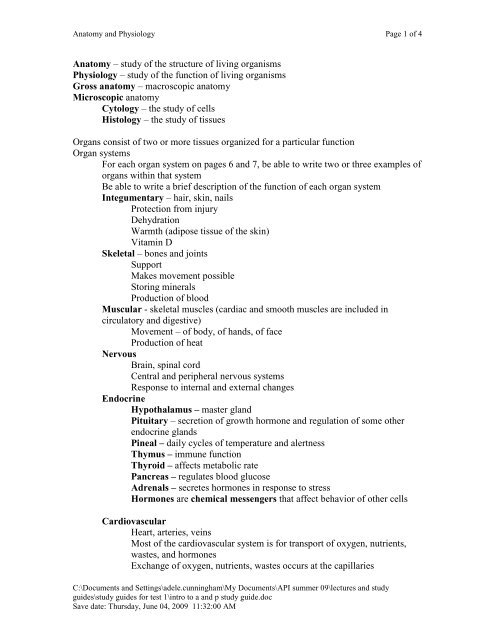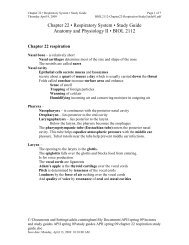Study guide Chapter 1
Study guide Chapter 1
Study guide Chapter 1
Create successful ePaper yourself
Turn your PDF publications into a flip-book with our unique Google optimized e-Paper software.
Anatomy and Physiology Page 1 of 4<br />
Anatomy – study of the structure of living organisms<br />
Physiology – study of the function of living organisms<br />
Gross anatomy – macroscopic anatomy<br />
Microscopic anatomy<br />
Cytology – the study of cells<br />
Histology – the study of tissues<br />
Organs consist of two or more tissues organized for a particular function<br />
Organ systems<br />
For each organ system on pages 6 and 7, be able to write two or three examples of<br />
organs within that system<br />
Be able to write a brief description of the function of each organ system<br />
Integumentary – hair, skin, nails<br />
Protection from injury<br />
Dehydration<br />
Warmth (adipose tissue of the skin)<br />
Vitamin D<br />
Skeletal – bones and joints<br />
Support<br />
Makes movement possible<br />
Storing minerals<br />
Production of blood<br />
Muscular - skeletal muscles (cardiac and smooth muscles are included in<br />
circulatory and digestive)<br />
Movement – of body, of hands, of face<br />
Production of heat<br />
Nervous<br />
Brain, spinal cord<br />
Central and peripheral nervous systems<br />
Response to internal and external changes<br />
Endocrine<br />
Hypothalamus – master gland<br />
Pituitary – secretion of growth hormone and regulation of some other<br />
endocrine glands<br />
Pineal – daily cycles of temperature and alertness<br />
Thymus – immune function<br />
Thyroid – affects metabolic rate<br />
Pancreas – regulates blood glucose<br />
Adrenals – secretes hormones in response to stress<br />
Hormones are chemical messengers that affect behavior of other cells<br />
Cardiovascular<br />
Heart, arteries, veins<br />
Most of the cardiovascular system is for transport of oxygen, nutrients,<br />
wastes, and hormones<br />
Exchange of oxygen, nutrients, wastes occurs at the capillaries<br />
C:\Documents and Settings\adele.cunningham\My Documents\API summer 09\lectures and study<br />
<strong>guide</strong>s\study <strong>guide</strong>s for test 1\intro to a and p study <strong>guide</strong>.doc<br />
Save date: Thursday, June 04, 2009 11:32:00 AM
Anatomy and Physiology Page 2 of 4<br />
Respiratory<br />
Exchange of oxygen and carbon dioxide at the lungs<br />
Digestive<br />
GI tract – esophagus, stomach, pancreas, small and large intestines,<br />
Breaks down nutrients so they may be absorbed<br />
Removes indigestible matter in the feces<br />
Urinary<br />
Kidneys<br />
Ureters<br />
Bladder<br />
Urethra<br />
Removal of urea (nitrogenous wastes)<br />
Return of water, salts, and other substances to the bloodstream<br />
Secretion of hormones that affect hematocrit (red blood cell count) and<br />
blood pressure<br />
Lymphatic system<br />
Thymus, spleen, lymph vessels<br />
Returns fluids to the circulatory system<br />
Nodes and organs provide sites of immune activity<br />
Reproductive<br />
Mammary glands<br />
Vagina, uterus, fallopian tubes, ovaries<br />
Testes, penis, vas ductus or vas deferens, prostate<br />
Production of sex hormones and gametes<br />
Development of embryo<br />
Nourishment of newborn<br />
Homeostasis<br />
The state of equilibrium/stability of the body’s internal environment. The body<br />
normally maintains the internal environment within a range of values. For instance, pH is<br />
maintained between 7.35 and 7.45 and body temperature normally fluctuates by only a<br />
few degrees during the day.<br />
The hypothalamus detects body temperature that is too high or too low.<br />
If body temperature is too high, then the hypothalamus signals sweat glands to open and<br />
small blood vessels near the skin to dilate to bring body temperature back down. Once<br />
body temperature is back down, the hypothalamus stops sending a signal to sweat glands<br />
and small blood vessels near the skin. This is the negative feedback, a self-regulating<br />
process. If body temperature is too low, the hypothalamus sends a signal for small<br />
blood vessels to constrict and muscles begin to shiver. Once the body temperature is<br />
back to normal, desirable range, the signal from the hypothalamus ends. This is another<br />
example of negative feedback.<br />
C:\Documents and Settings\adele.cunningham\My Documents\API summer 09\lectures and study<br />
<strong>guide</strong>s\study <strong>guide</strong>s for test 1\intro to a and p study <strong>guide</strong>.doc<br />
Save date: Thursday, June 04, 2009 11:32:00 AM
Anatomy and Physiology Page 3 of 4<br />
Homeostasis of salt concentration<br />
If concentrations of salts are too high in the blood, the hypothalamus sends a signal<br />
through a hormone called ADH to the kidney tubules which begin to absorb more<br />
water back into the blood. Once the concentration of salts comes back into normal<br />
homeostatic range (the range of salt concentrations that your body tries to maintain), the<br />
signal from the hypothalamus stops. This is another example of negative feedback. The<br />
hypothalamus also generates the feeling of thirst.<br />
Positive feedback – a self-reinforcing process that is turned off by some external event<br />
Example – oxytocin and contractions of uterus – birth ends the process<br />
Formation of a blood clot – formation of the clot stops process of attracting more<br />
platelets<br />
Language of anatomy<br />
Major divisions of the body<br />
Axial, head, neck and torso<br />
Appendicular – arms and legs<br />
Anatomical position<br />
Anatomical position is a view of someone standing erect with arms slightly extended,<br />
palms facing forward, and feet slightly apart.<br />
Body planes and sections<br />
Midsagittal is a plane that divides the body into equal left and right sections<br />
Parasagittal is a plane that divides the body into unequal left and right<br />
sections.<br />
Transverse is a plane parallel to the floor (in anatomical position) that divides the body<br />
into upper and lower sections<br />
Frontal is a plane that divides the body into anterior and posterior sections.<br />
Oblique is a plane through the body that is not either horizontal or vertical.<br />
Orientation and directional terms are used to compare where one part of the body is<br />
compared to another<br />
Superior – toward the head<br />
Inferior – toward the feet<br />
Ventral – toward the anterior<br />
Dorsal – toward the posterior<br />
Lateral - toward the side<br />
Medial – toward the midline<br />
Proximal – toward the point of attachment of a limb<br />
Distal – away from the point of attachment of a limb (proximal and distal are usually<br />
used to refer to points along the arms or legs)<br />
Deep - toward the inner body<br />
Superficial – toward the skin<br />
C:\Documents and Settings\adele.cunningham\My Documents\API summer 09\lectures and study<br />
<strong>guide</strong>s\study <strong>guide</strong>s for test 1\intro to a and p study <strong>guide</strong>.doc<br />
Save date: Thursday, June 04, 2009 11:32:00 AM
Anatomy and Physiology Page 4 of 4<br />
Body cavities<br />
Dorsal body cavity<br />
Is a cavity formed by the meninges that encases the brain and spinal cord<br />
The spinal cord is an extension of the brain<br />
Ventral body cavity – contains the vital organs or viscera. The diaphragm divides the<br />
ventral body cavity into the thoracic and abdominopelvic cavities.<br />
Thoracic cavity<br />
Pleura (cavities for the lungs)<br />
Mediastinum body cavity includes the trachea, the esophagus, and the<br />
pericardium which is the cavity around the heart<br />
Abdominopelvic cavity<br />
Examples of organs within the abdominal part of the abdominopelvic<br />
cavity are<br />
Liver<br />
Spleen<br />
Small and large intestine<br />
Examples of organs within the pelvic regions are<br />
bladder<br />
rectum<br />
uterus<br />
The abdominal and pelvic regions are continuous<br />
Body cavities and organs are lined by membranes called serosa or serous membranes.<br />
These are double-walled membranes. The wall that lines a body cavity is called parietal.<br />
The wall that lines an organ is called visceral.<br />
The space between the parietal and visceral walls is filled with serous fluid. This fluid<br />
lets organs, for instance the lungs and heart, move smoothly within the body.<br />
At the arteries (heart) or bronchi (lungs), the parietal layer turns inward and becomes the<br />
visceral layer.<br />
Infections of the serous fluid<br />
Infections can cause adhesions to the body cavity and pain.<br />
Infection of the peritoneum, the serous membrane around the abdominopelvic<br />
cavity is called peritonitis<br />
Infections of the pleura – pleurisy<br />
Infections of the pericardium (serous membranes around the heart) are called<br />
pericarditis. Severe pericarditis is called cardiac tamponade because the<br />
increase in fluid around the heart obstructs contractions of cardiac muscle.<br />
C:\Documents and Settings\adele.cunningham\My Documents\API summer 09\lectures and study<br />
<strong>guide</strong>s\study <strong>guide</strong>s for test 1\intro to a and p study <strong>guide</strong>.doc<br />
Save date: Thursday, June 04, 2009 11:32:00 AM
















